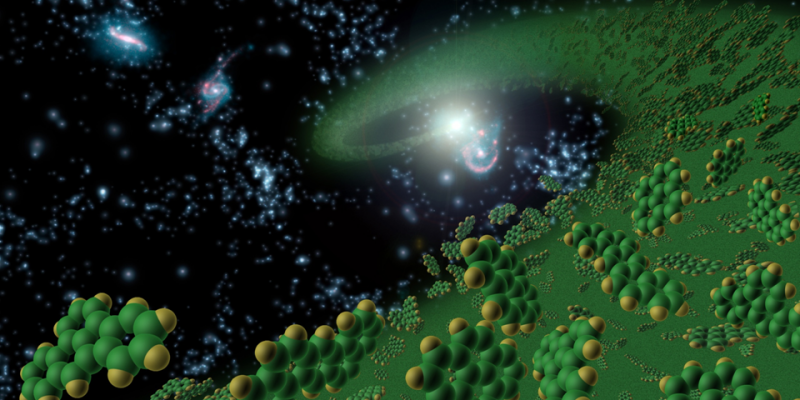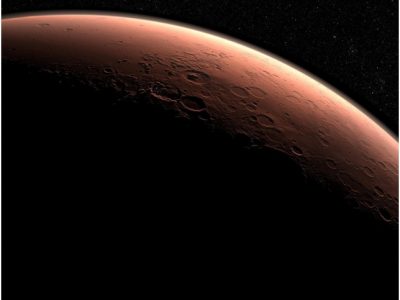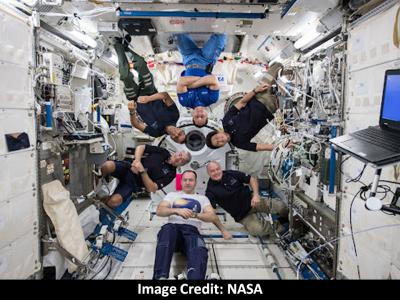
What are particles?

Space and Particles by JanRobbe on DeviantArt (Credit: DeviantArt)
Scientists have been wondering about what life and its original components are for thousands of years. According to most ancient cultures, life and all existence were formed from the essential elements of nature – earth, air, wind, water, and fire. Over time, many philosophers have put forward the idea that all things consist of small, indivisible things that cannot be created or destroyed (called particles).
This proposition was largely philosophical, and it was not until the emergence of modern atomic theory and chemistry that scientists assumed that the meeting of molecules together constituted the basic structure of all things.
Named molecules, it is a Latin word where moles mean mass or barrier. Its use in the context of modern particle theory, however, refers to small units of mass.
Definition:
By its traditional definition, molecules are the smallest part of a substance that preserves the chemical and physical properties of matter. It is composed of two or more atoms, and a group of similar or different atoms is bound together by chemical bonds.
Molecules may consist of a single chemical element, such as the oxygen molecule, or from different elements, as is the case with the water molecule. As components of matter, molecules are found in organic matter (and thus in biochemistry) and are what lead to life-forming elements, such as liquid water and breathable air.
Types of links:

An Illustration of Particle links (Credit: Pinterest)
Molecules are bound together by one of two types of bonds, covalent or ionic. A covalent (participatory) is the bond that atoms share with electron pairs. The bond is formed as a result of a stable balance of attraction and repulsion forces between atoms.
In contrast, ionic bonds involve the electrical attraction between opposite ions with a charge. The electrolytes that make this kind of bond are atoms that have lost one or more electrons (which have become positively charged and are called cations or analogues), and which have acquired one or more electrons (they have become negatively charged and called anions or chirps).
Unlike sharing, this transition is called electronic parity. In the simplest form, ionic bonds are formed between a metal atom (cation) and a nonmetallic atom (anion), producing compounds such as NaCl sodium chloride or Fe2O3Fe2O3 (salt and rust).
However, more complex structures can be obtained from the covalent bond, such as ammonium NH + 4NH + 4, and hydrocarbons such as methane CH4CH4 and ethane C2H6C2H6.
History of the study of molecules:
Historically, molecular theory and atomic theory have been intertwined. The first indication that matter is composed of “preserved units” began in ancient India when practitioners of medicine adopted in Jainism the idea that all things are made up of small, indivisible elements that, in combination, form more complex bodies.
Leucippus and Democritus who were ancient Greece philosopher coined the term “atomos”, which refers to the smallest parts of indivisible matter, and the term “atom” is the modern derivation of “atomos”.
In 1661, the naturalist Robert Boyle argued in an essay on chemistry, titled “The Skeptical Alchemist,” that matter was composed of various combinations of “corpuscules” other than earth, air, wind, water, and fire. However, these observations were limited to the field of philosophy.
Atoms and molecules were not put into serious science until the late eighteenth and early twentieth centuries, with Antoine Lavoisier’s Law of Conservation of Mass and Dalton’s Law of Multiple Proportions.
The former had suggested that the elements are the basic materials that cannot be divided into smaller parts, while the latter suggested that each element consists of a single and unique type of atoms, which these elements can link with each other to form chemical compounds.
A new boon came in 1865 when Johann Josef Loschmidt measured the size of the particles that make up air, which gave insight into the size of the particles. The invention of the STM Scanning Tunneling Microscope (STM) in 1981 allowed for the first time also to directly see atoms and molecules.
At present, the concept of molecules has been refined because of ongoing research in the fields of quantum physics, organic chemistry, and biochemistry.
When it comes to searching for other forms of life, in other words, it becomes necessary to understand the requirements for the emergence of organic molecules from the sum of chemical building blocks.
Cosmological particles:
Scientists have found in the interstellar void, in the dust, it is generated from, a group of particles that had never been seen before in space. Traces of emissions from dense star-forming clouds have been discovered, a special type of class of molecules known as polycyclic aromatic hydrocarbons (PAHs), whose presence in space may help to unravel how and where these particles are formed.
“We have always thought that PAHs are already forming in the atmosphere of dying stars,” said Brett McGuire, an astrochemist at the Massachusetts Institute of Technology. “In this study, we found it in cold dark clouds, where stars had not yet begun to form.”
PAHs are not rare here on Earth, they appear often without even looking for them, and they can be found in crude oil formed from the remains of organisms such as zooplankton and algae that are exposed to extremely high heat, as well as coal formed from plants after subjecting to tremendous pressure and heat.
Most of the origins of polycyclic aromatic hydrocarbons in the universe are due to non-biological sources, but they may come from biological sources as well. Previous analysis indicates that 15% of all interstellar carbon in galaxies, including ours, is associated with PAHs, most of which floats in interstellar space.
We now have evidence that PAHs are out there and not just individual molecules that can be found in the interstellar gas.
“We now have, for the first time, a direct window into the chemistry that will enable us to study how this massive stock of carbon interacts and evolves during the processes of star formation,” said McGuire.
The team’s research focused on the Taurus molecular cloud known as TMC-1, a cold, dense molecular cloud in the Taurus region 430 light-years away.
The team tracked PAHs in this cloud within the Gotham Project.
Molecular clouds are where small stars are born when a dense knot of gas collapses while rotating under the influence of their gravity, causing more material to be stored together than the surrounding cloud.
Inside the Taurus molecular cloud, the team found something different from what the models had predicted. The presence of PAHs was expected, but their availability was much higher than expected.
The last paper details the discovery of cyanophtalin 1 and 2, and the results of recent months’ research by McGuire and his team demonstrate the immense value of what they uncovered using data-gathering techniques as the presence of the isomorphic cyanobulin and other compounds were discovered.
“We come across a new set of molecules that differ from any previously observed, which will completely change our understanding of how the particles interact,” said McGuire.

Taurus molecular cloud is known as TMC-1 (Credit: Lab Manager)
When the particles are large enough to form the origins of stellar dust, they can influence the composition of asteroids, comets, planets, the surfaces on which the ice forms, and the locations of planets within stellar systems.
We do not know the exact explanation for the presence of this abundant cyanaftalin in the Taurus molecular cloud, as it either formed there or moved there from another place, and perhaps a combination of the two possibilities.
We know now that he’s out there, and he’s somehow gotten there, figuring out the rest is just a matter of time.
The study also shows that the chemistry of molecular clouds may be richer and more complex than we think, representing a new way of understanding the universe.
Astronomical chemist Michael McCarthy of Harvard University described this discovery surprisingly, as these particles have never been sufficiently explored or researched. “This makes us wonder about the things in space without discovering them yet,” he added.
The Detection of a hot extra-galactic molecular nucleus
Astronomers have discovered a “hot molecular nucleus,” which is a covering of particles that surrounds (wraps) a giant baby star, for the first time outside our galaxy.
This discovery is an important and initial step in studies of observing hot particles outside galaxies that challenge the hidden chemical diversity of our universe, and was published in a study in the Journal of Astrophysics Volume 827, “Astrophysical Journal Volume 827.”
Scientists from Tohoku University, the University of Tokyo, the Japanese National Astronomical Observatory, and the University of Tsukuba used a group of telescopes located in the Atacama Desert in Chile, known as ALMA, to observe the nascent star located in the Magellanic Cloud. The largest, and it is one of the nebulae close to our galaxy.
These observations led to the discovery of many lines of radiation emissions from various gaseous particles, which indicate the presence of a hot molecular core accompanying this nascent star.
These observations showed that this hot molecular core in the Large Magellanic Cloud contains chemical components that are distinctly different from those in our galaxy. In particular, the results assumed a lower presence of simple organic molecules such as methanol, and thus the possibility of large organic species necessary to initiate life is difficult.
The researchers suggested that the unique galactic environment of the Great Magellanic Cloud affects the processes of formation of particles around the nascent star, and this is what this unique chemical formation that has been observed shows.
Dr Takashi Shimonishi, an astronomer at Tohoku University in Japan and lead author of the letter, says:
“This is the first discovery of a hot molecular nucleus outside the galaxy, and it demonstrates the great ability of new generations of telescopes to study astronomical phenomena outside our galaxy.” “These observations suggest that the chemical composition of the elements that make up stars and planets is more diverse than we think,” he adds.
As it is known, the complex and different chemical molecules that are related to molecules formed in space before the emergence of life are discovered from the hot molecular nuclei in our galaxy. But even so, it is not clear whether such large and complex particles exist in other galaxies.
The new discovery provides a wonderful target for such a study, and the upcoming observations of such hot molecular cores will shed light on the complex chemical makeup of our universe!
Suggested Reading 1: The Oh My God Particle
Suggested Reading 2: Get out of my ‘Space’: Satellite Technology and the Race to Dominate Space
Author













[…] Suggested Reading: Particles in space: The discovery of unidentified ones […]